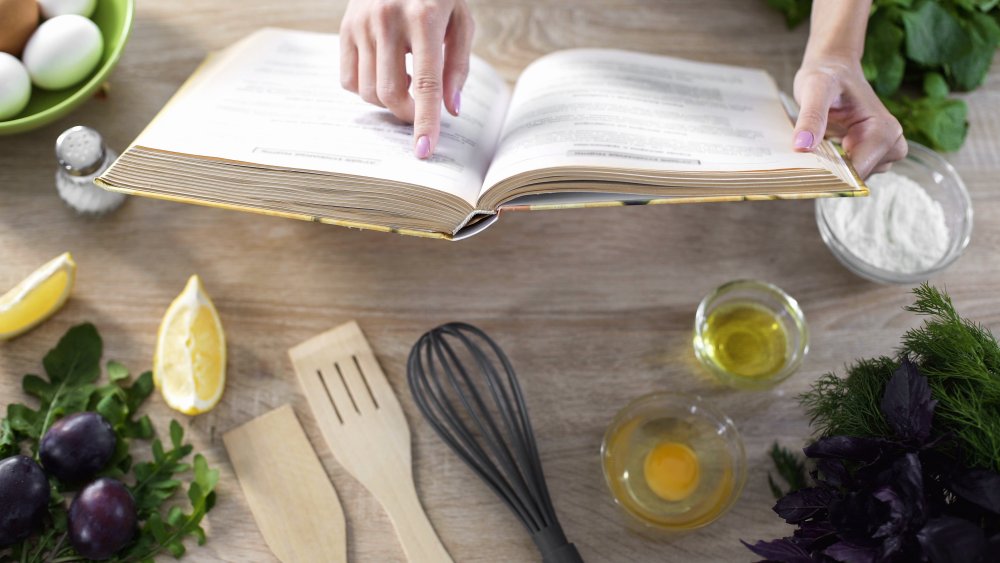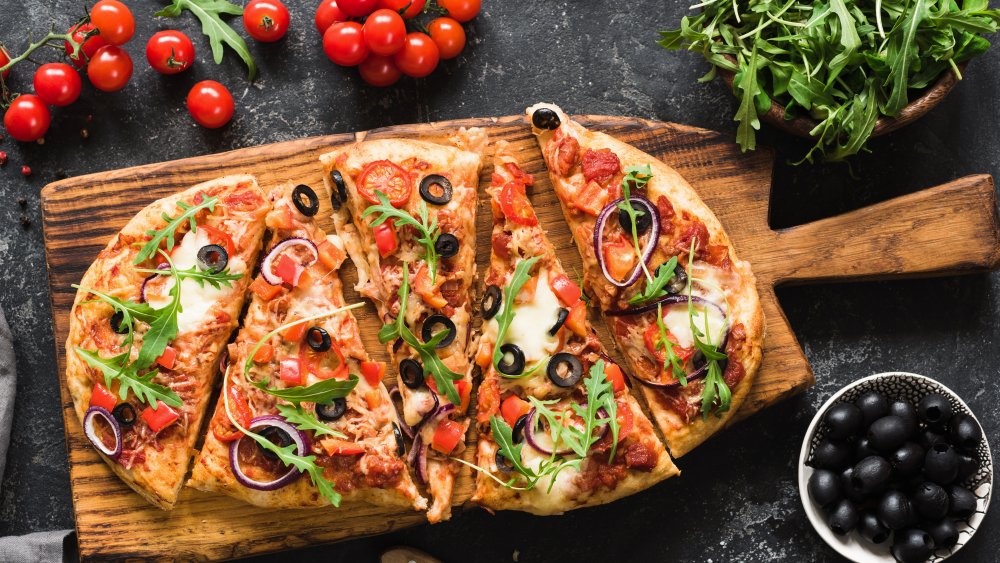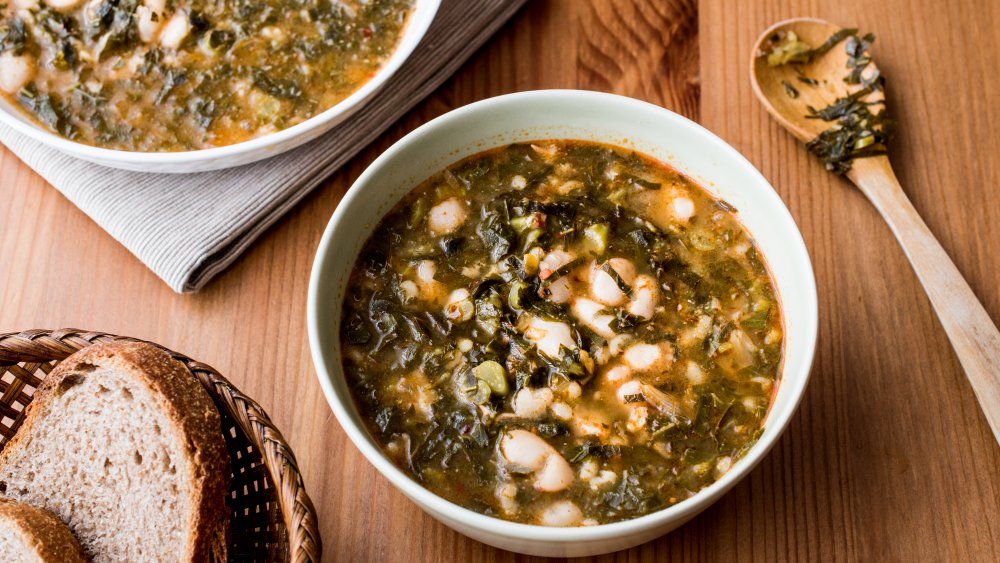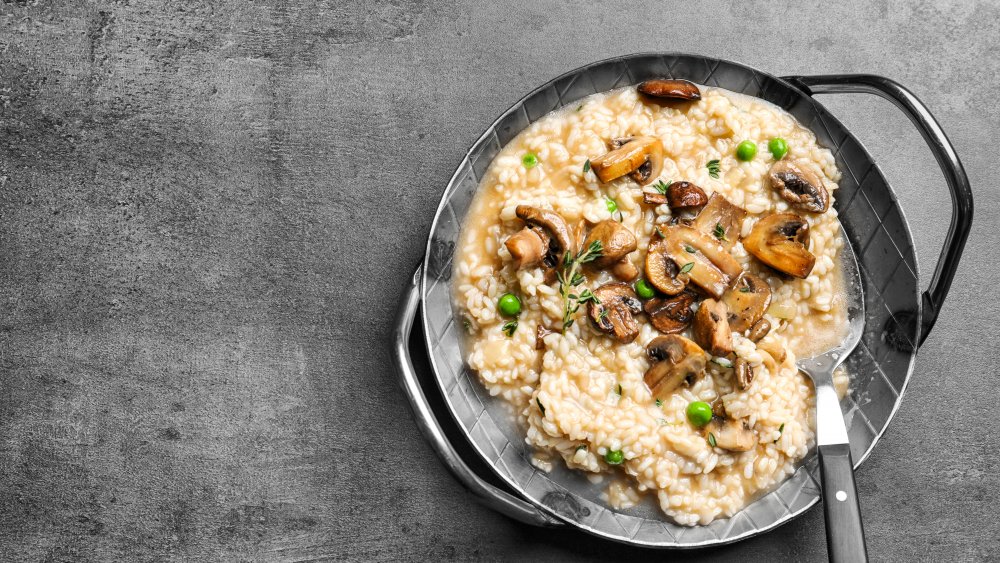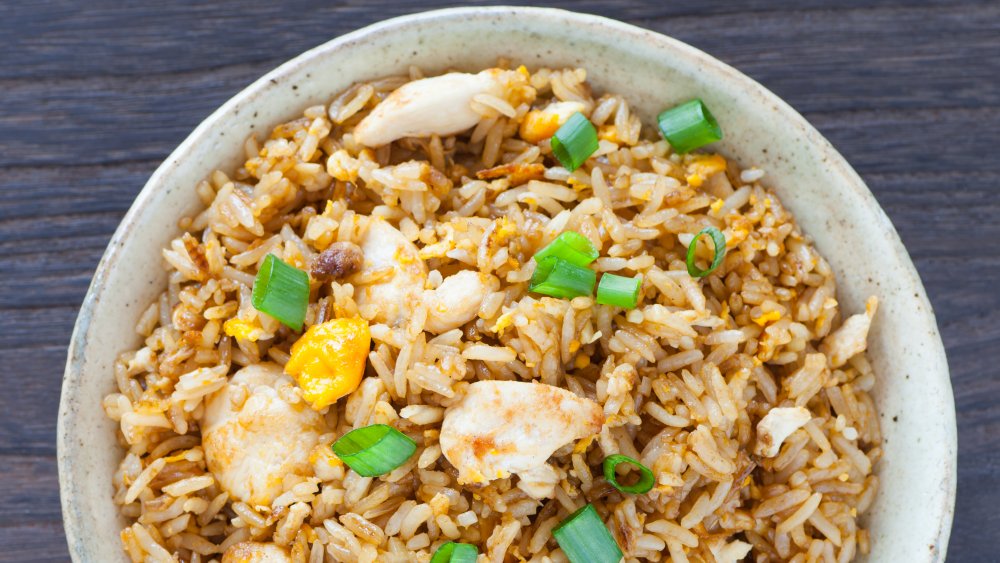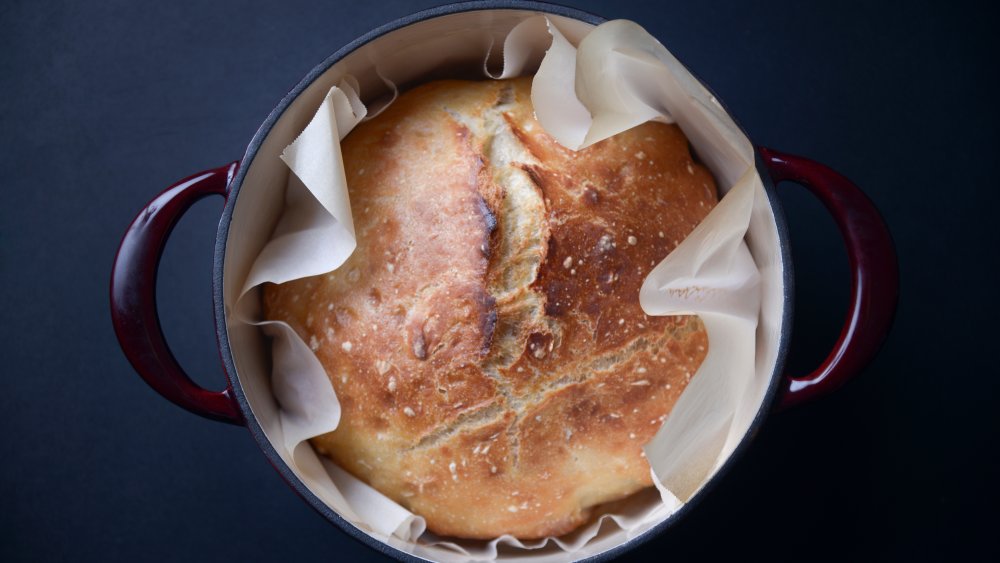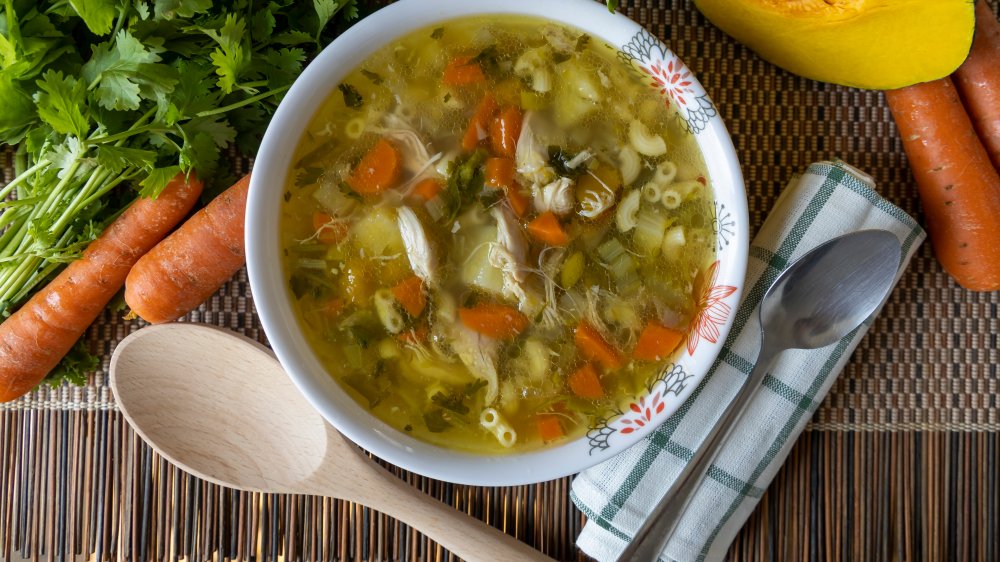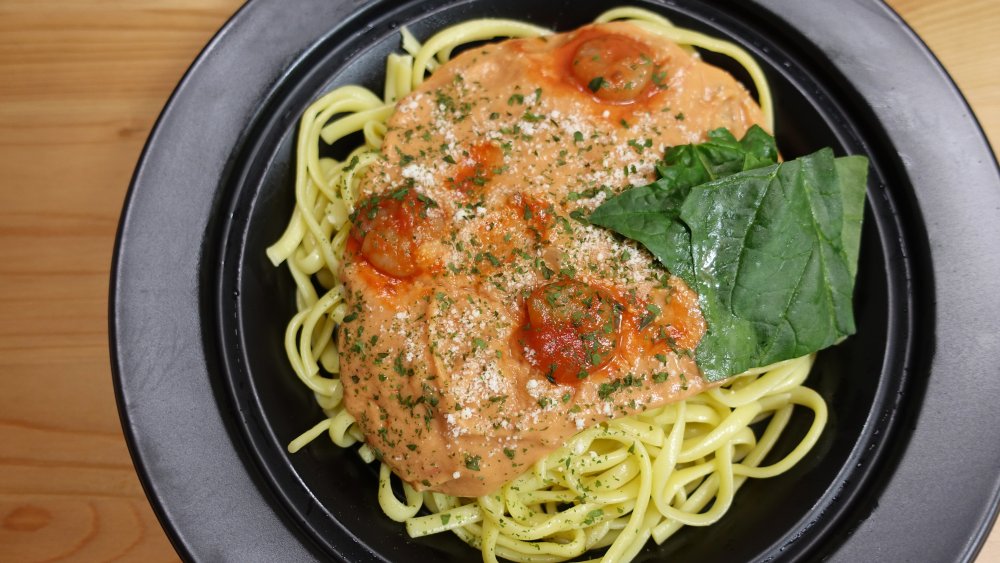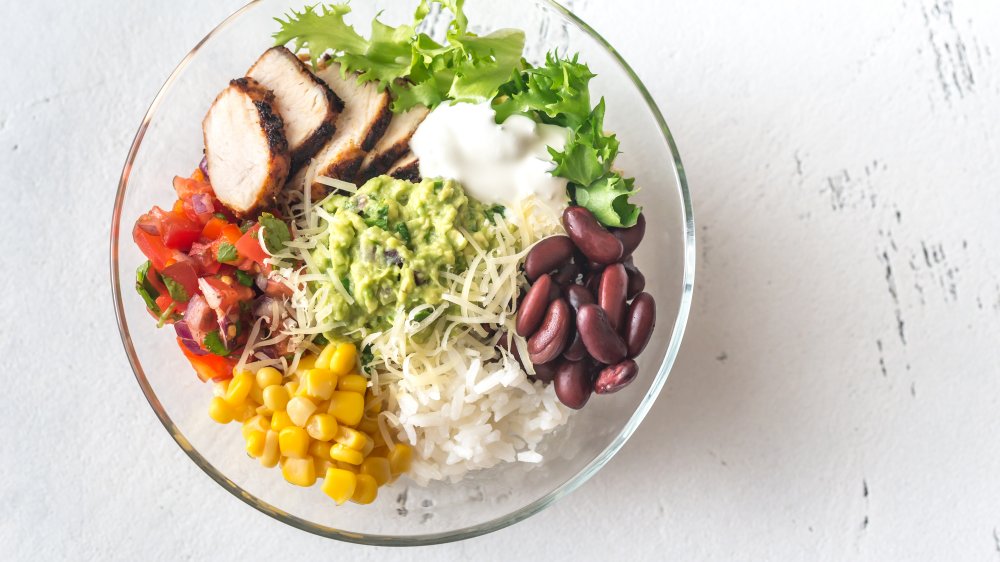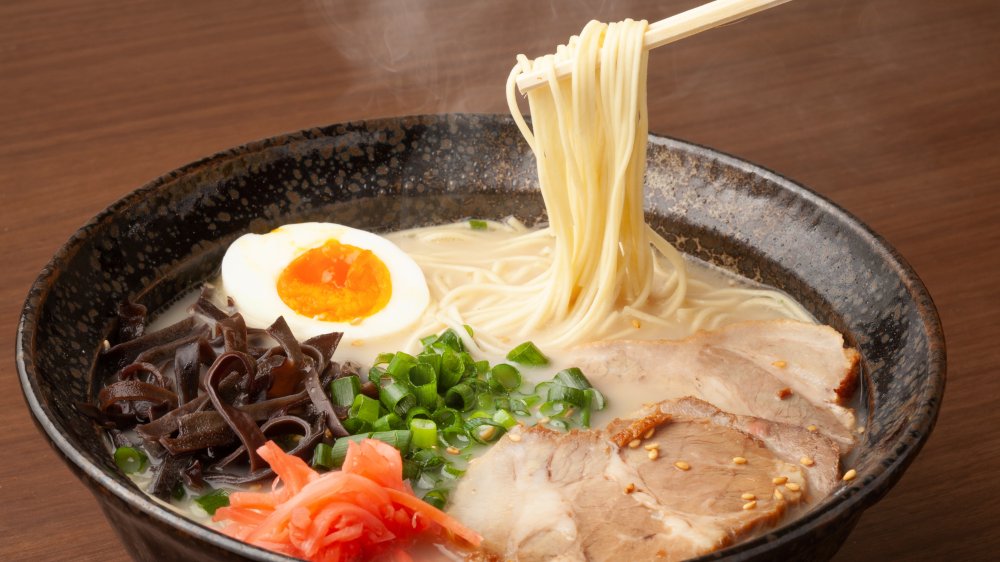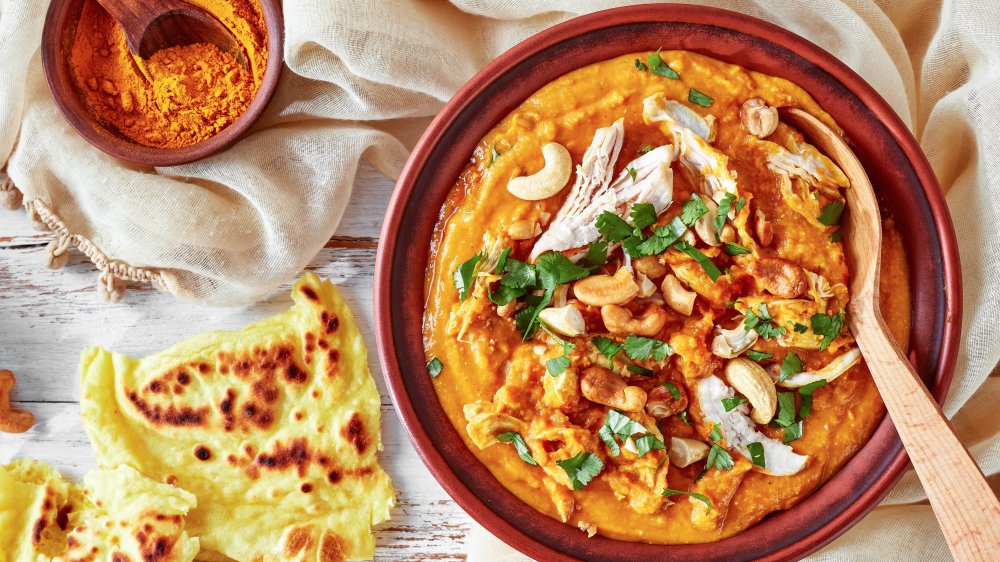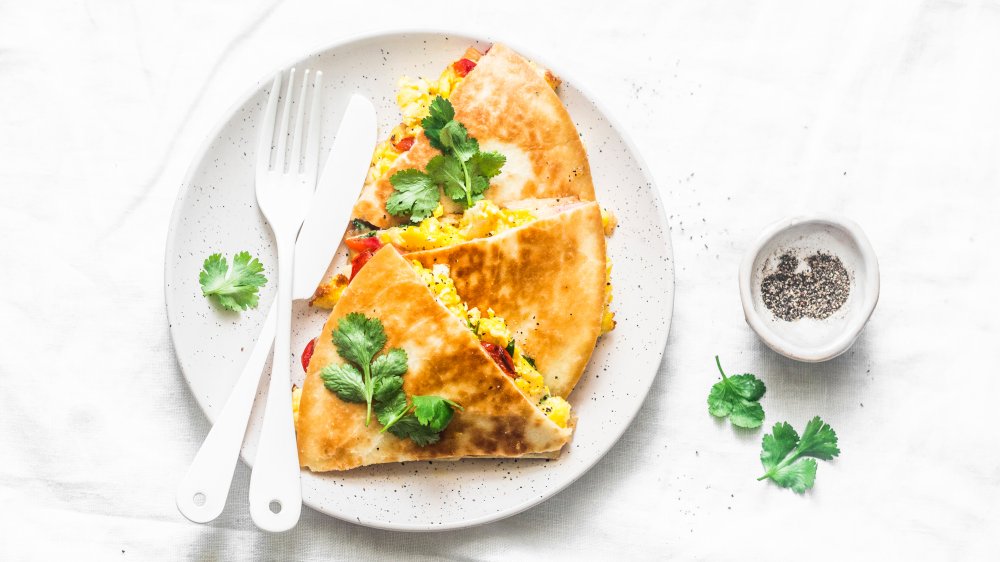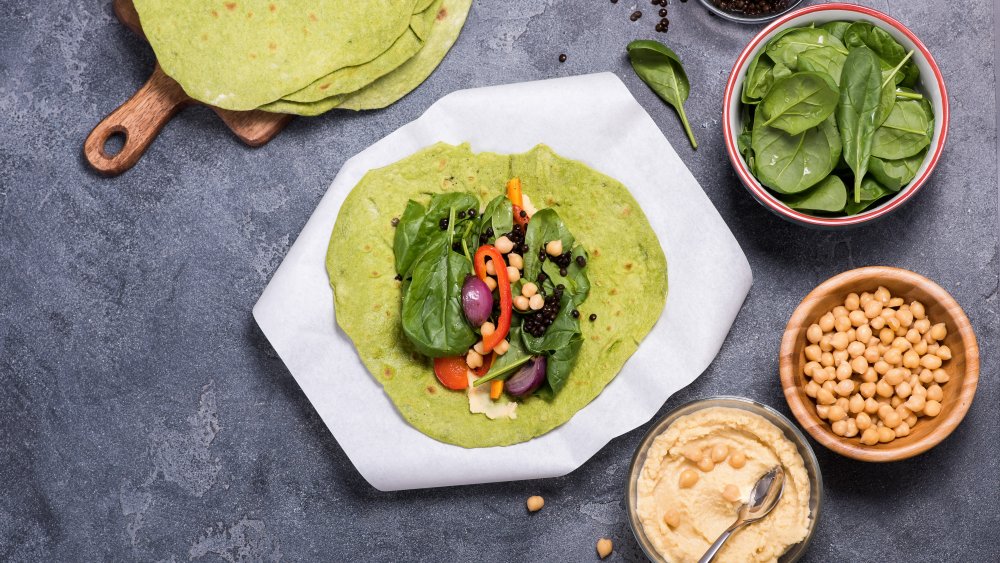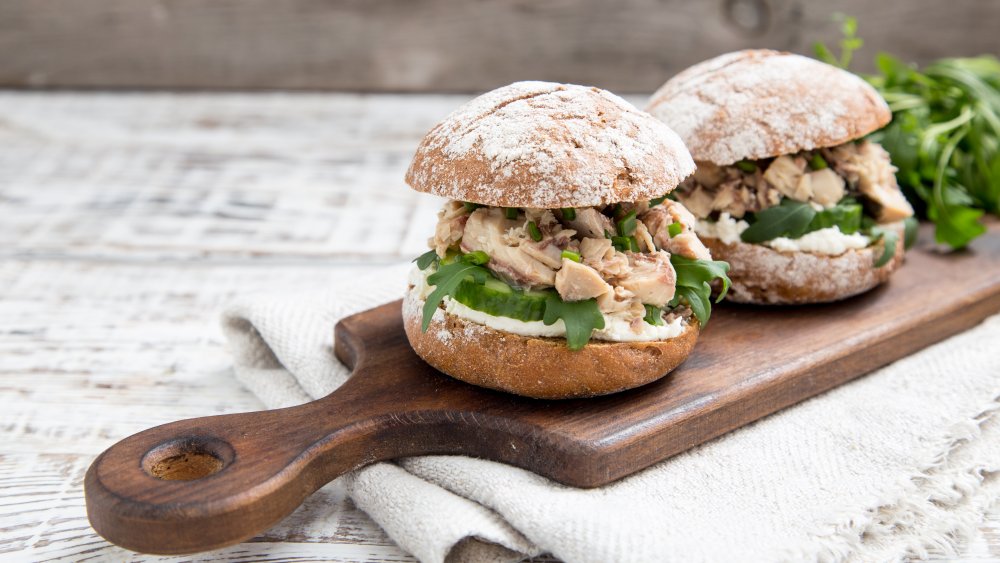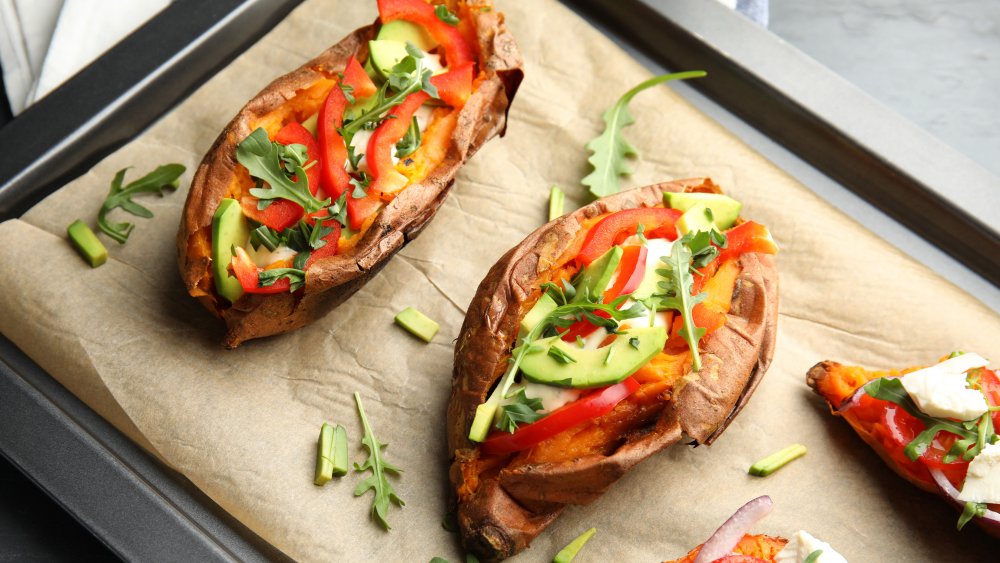The Best Recipes To Make While Quarantined
In the wake of COVID-19 (also known as the coronavirus), many of us have stocked up at the grocery store. We have all the pantry essentials we need to wait out the storm, like beans, rice, canned goods, and frozen foods. The only problem: Now we have to figure out how to cook all that food! If the idea of cooking dinner sounds more intimidating than ever, we understand. Your routine is interrupted, and you may have to juggle working from home with keeping your kids educated and entertained. But there is a silver lining to all this self-quarantining: The opportunity to hone-in your cooking skills.
Practicing social distancing or self-quarantine doesn't mean you have to resign yourself to frozen meals, ramen noodles, and canned soup. These are the best recipes to make while quarantined. Spoiler alert: They're not only easy to make and contain long-lasting, shelf-stable ingredients, but many of them are also healthy, too.
Homemade pizza
During uncertain times, it's good to reach for something familiar. You may not be able to get your favorite take-out pizza these days, but it's easier than you think to make one at home. All you need is some sauce (tomato sauce, pesto, or Alfredo), mozzarella cheese, and a few toppings. Most of these items have a long shelf life, too — pepperoni or salami, ham, frozen sausage, chopped olives, pickled jalapenos, dried herbs, and more.
When it comes to dough, you can stock up on frozen pizza shells at the store, or you can use extra-large burrito-sized tortillas to make pizzadillas. Our favorite homemade dough isn't traditional, this no-yeast flatbread recipe is super easy. It doesn't require any rise time, so you can decide to make pizza ten minutes before you're ready to bake it.
Grab a large bowl and combine two cups of self-rising flour with one cup of yogurt. If you don't have self-rising flour, add two teaspoons of baking powder and a pinch of salt to all-purpose flour. Knead the mixture with your hands until the dough comes together. Divide it into two dough balls, roll them out with a rolling pin, and add your favorite pizza toppings. Bake the pizza at 450 degrees Fahrenheit for 8 to 10 minutes, until the cheese is melted and the dough is cooked through. Simple, delicious, satisfying.
Slow cooker sausage, kale, and white bean soup
Our slow cooker has come to the rescue on so many occasions, so there's no need to stop using it now. The slow cooker is a fantastic way to take advantage of the bounty of dried beans you might have picked up at the grocery store. According to the Bean Institute, using a slow cooker is not only the easiest way to cook dried beans, but you also don't need to worry about soaking the beans (with the exception of kidney beans). Simply give them a rinse, plop them in the slow cooker with a pinch of salt, and cover the beans with two inches of cold water.
Our favorite slow cooker bean recipe involves sausage and kale. You can use any type of bean, but we like white beans best. They have a creamy texture that contrasts perfectly with the bold flavor of the sausage. All you need to make this recipe happen is four links (or one pound) of sausage. If it's raw sausage, brown it in a skillet before adding it to the slow cooker. Then add one cup of dried beans, four cups of chicken broth or water, a few bay leaves, some dried thyme, and chopped onions, carrots, and celery. Cook on low for six to eight hours, until the beans are tender. Then, season with salt and black pepper, and stir in four cups of chopped kale. Continue to cook until the kale is wilted and tender.
This soup freezes exceptionally well, so feel free to double the recipe if it will fit in your slow cooker.
Instant Pot risotto
Risotto is one of our favorite vegetarian dishes. It's rich and creamy with a silky, smooth texture. Unfortunately, risotto has a reputation for being difficult to make. You have to add the broth one ladle at a time and constantly stir to coax out the rice's starch molecules and create the perfect texture. Luckily, the Instant Pot comes to the rescue. It's a zero-effort way to make this comforting dish with pantry staples and any fresh (or frozen) vegetables you have on hand.
We'll start by using the Instant Pot's saute function to cook a few vegetables in butter with a pinch of salt and pepper. This can be anything you like — onions, garlic, mushrooms, asparagus, chopped broccoli, bell peppers, you get the idea. Then, add a cup of arborio rice, two cups of broth or water, and aromatic herbs like rosemary or thyme. Cook on high pressure for six minutes and quick-release the pressure using the manufacturer's guidelines. Stir in a pat of butter for extra flavor and add any tender vegetables (like spinach or peas). Feel free to add copious amounts of Parmesan cheese, too, to amp up the rich flavor. It's as easy as that!
Easy fried rice
If the cravings for take-out are strong, you're in luck: Homemade fried rice is unbelievably easy to make. Technically, you only need three ingredients to make it happen: rice, eggs, and soy sauce. White rice is good in the pantry for four to five years, and soy sauce will last for a year or two after it's been opened. Eggs have a shorter shelf life, but even they can last three to five weeks in the refrigerator.
If you have cooked rice on hand, this easy fried rice recipe only takes 15 minutes. To add extra flavor and nutrition to the dish, start by cooking chopped onions, carrots, bell peppers, and garlic in hot oil until they're softened. Then, add two cups of cooked, chilled rice and some chopped green onions to the pot and cook until the rice is heated through. In a small bowl, scramble two eggs with two tablespoons of soy sauce. Push the rice to one side of the pan, add an extra splash of oil or butter to the empty side, and add the egg to the oil. When the egg is cooked, mix it into the rice. Season the rice with extra soy sauce to taste, and feel free to add in extra veggies if you like — this is a great opportunity to use those packages of frozen stir fry vegetables.
No-knead bread
Life often gets in the way of learning how to bake something like bread, which requires extended periods of time for rising. But having a bread recipe in your back pocket is the perfect way to combat empty shelves at the grocery store. Bread only requires four shelf-stable ingredients — flour, yeast, salt, and water — and it's easier to make than you'd think.
The easiest recipe to tackle as a beginner is a no-knead bread. This recipe makes enough dough for four loaves, but you'll store the dough in the refrigerator for up to seven days and you can bake fresh bread every day. Start by combining 7-1/2 cups of all-purpose flour with three cups of lukewarm water, one tablespoon of kosher salt, and two packages of active dry yeast in a very large bowl. When the dough comes together, form it into a ball and let it rise for two hours at room temperature before putting it in the refrigerator. When you're ready to bake, pull off a grapefruit-sized dough ball (about a quarter of the dough) and form it into a ball or log. Let it come to room temperature on a parchment-lined baking sheet or Dutch oven for an hour before baking it in a 450 degree Fahrenheit oven for about 30 minutes. The hardest part of this process is letting the bread cool — it's really difficult to slice when it's warm.
Chicken noodle soup
Chicken soup was practically made for quarantine situations. It's easy to make, only requires a handful of ingredients, and it's warm and comforting. Plus, many people already look to chicken soup when they're feeling under the weather because it contains vitamins, minerals, and antioxidants, so this recipe may also add an extra boost to your immune system.
You can make chicken noodle soup in the slow cooker, Instant Pot, or on the stove top. No matter which method you choose, you'll want to combine two quarts of chicken stock with chopped vegetables (like onions, carrots, celery, and garlic) and three pounds of bone-in chicken. Bone-in chicken will add the most flavor and gelatin to the soup, but you could use 2-1/2 pounds of boneless chicken if you prefer. Simmer the mixture until the chicken is cooked through. Remove the bones and shred the meat. Return the chicken to the soup along with eight ounces of extra-wide egg noodles. Cook until the pasta is tender. When you're ready to eat, garnish the soup with fresh chopped herbs (parsley and dill are our favorites) and dig in.
Creamy tomato pasta
Dried pasta can be a lifesaver in quarantine situations. You can combine it with so many different ingredients to create all kinds of pasta variations. A simple pasta can be made with nothing more than butter, garlic, and Parmesan cheese, or you can make it fancy by adding any number of fresh or frozen vegetables. To amp up the protein content, add bacon, ground beef, sausage, chicken, pork, tofu, or beans. Pasta dishes can be baked into filling casseroles in the oven, or they can be made in a single pot on the stove top.
Our favorite quick-and-easy weeknight dinner is a creamy tomato pasta. You can use any type of noodle, from shapes like penne to flat linguine or spaghetti. While you're boiling a pound of pasta, cook a finely chopped onion in a skillet with some oil or butter. When the onion is tender, add dried herbs (like thyme, basil, oregano, garlic powder, and red pepper flakes) and cook for a minute to let the spices bloom. Add a 28-ounce can of crushed tomatoes and bring the mixture to a simmer. Cook for about 10 minutes before adding 1/2 cup of heavy cream, sour cream, or yogurt. Add the cooked pasta to the pan and toss to coat. Feel free to add any extra ingredients you have on hand. Ground beef or shrimp are great here, as is spinach and herbs like basil.
Rice and bean burrito bowls
Most people prepare for quarantine by stocking up on two very shelf-stable ingredients: rice and beans. Pair them together, and they create a complete protein — just like meat — containing all the essential amino acids our bodies need. There are an infinite number of ways to eat these two ingredients. Whip up an Indian kitchari with split mung beans, serve Cuban-style black beans over rice, or make Louisiana's famous red beans and rice.
Since we're missing our favorite Mexican take-out, we decided to make copycat Chipotle rice and bean bowls. The rice is easy enough to make — toss cooked rice with chopped cilantro, salt, lemon juice, and lime juice. From there, the fastest way to make rice and bean bowls is to heat up a can of black beans or pinto beans. Enjoy the bowls with fajita vegetables, or add a protein like shredded chicken, beef, or pork. Top it off with guacamole or sliced avocado, your favorite salsa, and a sprinkle of cheese.
Fancy ramen noodles
Okay, we know we said your quarantine eating experience doesn't have to be ramen noodles. But here's the thing: Ramen is super cheap, shelf-stable, and easy to store. But, when you use the included seasoning packet, it's not exactly healthy, containing 88 percent of the daily recommended intake of sodium. You might only be able to find shrimp-flavored ramen, anyway, so we recommend tossing out that packet and fancying up ramen noodles yourself.
Instead of starting with water, use high-quality broth instead. This could be chicken stock and beef broth, or even vegetable or seafood stock. To add extra flavor, stir in some soy sauce, oyster sauce, hoisin, sesame oil, chili garlic sauce, or chopped fresh garlic and ginger. After you cook the noodles in this flavorful broth, have some fun with the toppings. Add a soft-boiled egg, greens like spinach or bok choy, and thinly sliced meat. You can use cooked, leftover meat, but even deli meats work here. Some people even add American cheese to their ramen, so feel free to experiment when fancying up this simple meal.
Coconut lentil curry
Did you end up with a few cans of coconut milk when you raided the grocery store? We certainly hope so, because this coconut lentil curry is absolutely phenomenal. Most coconut curry recipes can be made with five ingredients or fewer if you have a jar of red curry paste on hand. You can eat this curry as-is in soup form, or pour it over cooked rice for a more filling meal. We also love pureeing until it's smooth so we can use it as a sauce for noodles or for smothering cooked fish, poultry, or meat.
Simply combine a can of coconut milk with a few tablespoons of red curry paste, 1-1/2 cups of dried red lentils, and two cups of broth or water. Simmer the mixture for about 20 minutes, until the lentils are tender, adding an extra cup of water if the mixture looks too dry. If you're not planning to puree the curry to use as a sauce, you can make the dish more filling by adding vegetables like chopped broccoli, spinach, or diced sweet potatoes to the mix.
Breakfast quesadillas
If you're getting bored with your breakfast routine, switch things up with this tasty breakfast quesadilla. Not that you couldn't enjoy this as breakfast for dinner or lunch, either. The basis of this recipe is fluffy scrambled eggs, crispy tortillas, and melted cheese, but you can also add in any number of additions. Consider the filling options before you get started. Chopped bacon, cooked sausage, roasted vegetables, sauteed spinach, and refried beans all make excellent options.
After you scramble your eggs, lay out a large tortilla on your workspace. Add a layer of shredded cheese before adding the eggs and any additional toppings. Sprinkle extra cheese on top before adding a second tortilla. Cook the quesadillas in a hot skillet with a tablespoon or so of cooking oil. When the bottom tortilla is lightly browned and crispy, flip the quesadilla over and repeat on the second side. Serve your tasty breakfast quesadillas with a side of salsa, sour cream, and avocado.
Hummus wraps
Hummus is an exceptionally versatile quarantine item because you can use it in so many different ways. It's fantastic when enjoyed as a snack with chips, or you can use it instead of mayonnaise on a sandwich. We've even added a dollop of hummus to grain bowls to add a creamy element to the dish. And, if you happened to stock up on beans when you're at the grocery store, you're in luck: Hummus is usually made with chickpeas, but you can make it with any type of bean.
Simply drain your can of beans and puree it in a food processor or blender with tahini, lemon juice, garlic, salt, olive oil, and smoky spices like ground cumin and paprika. Then, spread two or three heaping tablespoons of hummus onto a tortilla or pita flatbread. Add some canned roasted red peppers, chopped artichoke hearts, feta cheese, and greens like lettuce, spinach, or arugula. Wrap it up and enjoy a super healthy meal for lunch or dinner.
Tuna salad sandwiches
Canned tuna isn't exactly sexy, but it's an essential pantry staple when you're in quarantine mode. The typical shelf life of a can of tuna is three years, and it is good for about three days after it's been opened. You can use that can to make tuna casserole, toss it with pasta, or use it to create patties for tuna burgers. But, the easiest way to use a can of tuna is to make tuna salad sandwiches.
The base recipe is simple: tuna plus mayonnaise, mustard, and minced celery and onion. From there, you can have some fun and add secret ingredients. Try swapping out the mayonnaise and using hummus or mashed avocado instead. Or make it spicy by adding hot sauce, chopped pickled jalapenos, or pepperoncini. Give it an Italian flair by using Italian dressing, capers, and olives, or go Asian-style with wasabi, sesame oil, garlic, and ginger. The possibilities are endless!
Stuffed baked potatoes
If you have a pantry stocked with potatoes, grains, beans, meat, or vegetables, you have everything you need to make stuffed baked potatoes. The classic baked potato is usually filled with butter, sour cream, cheese, chives or green onions, and bacon. But once you start to think outside the box, a baked potato becomes the canvas for so many tasty meals. Baked potatoes are easy to prepare ahead of time, store in the refrigerator, and reheat when you're ready to eat, too.
For starters, you can make stuffed baked potatoes with russet (Idaho) potatoes or sweet potatoes. Bake them until they're soft all the way through using the oven or an Instant Pot. While the potatoes are baking, heat up your fillings. Some of our favorite options include: ground beef, tomato sauce, onions, and peppers for sloppy Joe potatoes; pepperoni, marinara, and mozzarella cheese for pizza potatoes; smoked salmon, cream cheese, capers, and red onions for New York potatoes; or quinoa, black beans, avocado, corn, and cheddar cheese for Southwest potatoes.
